Peakirk, Cambridgeshire (†Peterborough) c.1320
Passion Cycle
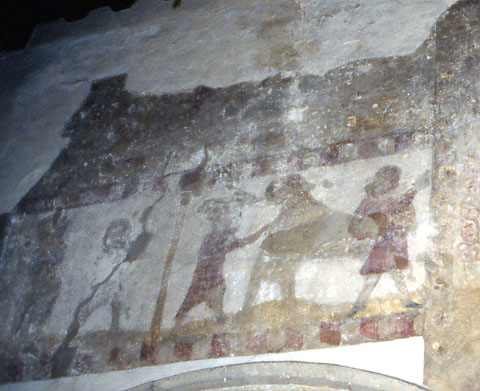
On the North Nave wall at Peakirk is a Passion Cycle in two tiers. Most of the upper tier, with scenes from the early part of the Passion story, is very faded now, but the lower is clearer; at the far left and shown left here are two scenes, the Scourging and the Road to Calvary. The former is obscure, but the general outline of a man with an upraised scourge is identifiable. To the right of this the Road to Calvary, clearer, shows Christ between two soldiers in short red tunics, one pushing, and one on the right pulling him along, probably by a rope around neck or waist.
At this point the sequence is interrupted by a large painting of St Christopher, the edge of which is visible at the right of the photograph. Although it is on a different scale, this painting is contemporary with the Passion Cycle and the placing is deliberate. The Middle Ages would have seen nothing particularly odd about this arrangement, and there are a few other comparable examples elsewhere.
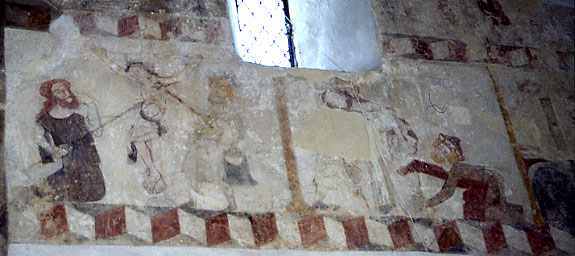
Beyond the St Christopher is, first, the Crucifixion, with the Miracle of Longinus, the blind soldier who pierced Christ’s side with the lance and whose sight was restored by the spurting blood. Stephaton, with the sponge and bucket of vinegar, is at the left and beyond that, to the right of the illusionistic yellow pillar dividing the scenes, is the Deposition. The kneeling man in the flat-crowned hat, helping to lift Christ from the Cross is probably Nicodemus, whose hat is of a kind conventionally used to identify a Rabbi, painted so sympathetically that he is shown in enlarged detail at the right here.
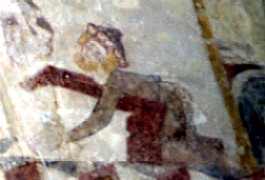
Little can be salvaged from the obscurity of the remaining scenes, but two of them are just discernible and are now included. Beyond the Deposition is a scene recognisable as the Entombment, but otherwise too faint and fragmentary to show here. To the right of that though is the Resurrection, shown below at the left.
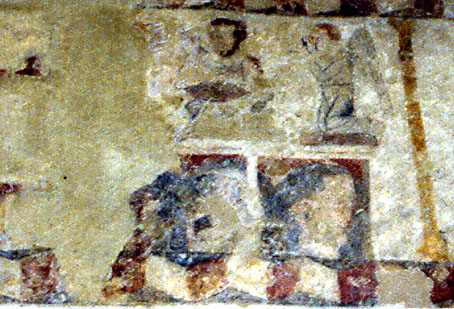
Much has gone, but part of a large sarcophagus is visible. The details on the ‘front’ once showed hunched, sleeping soldiers in 14th century armour. Christ rises from the tomb in the centre, his right hand raised, and at the right beyond him an angel kneels on top of the sarcophagus – his companion angel at the other side has gone. The kneeling posture here is very well handled – many kneeling figures in this kind of painting are awkward and toppling, but this angel is confidently and convincingly posed.
Finally, barely emerging from the general dimness, is the Appearance to Mary Magdalene, with her own figure, kneeling, faintly visible at the left. Christ, separated from Mary by a tree identified in the (excellent) church booklet as a pollarded willow, locally familiar, is further right, but little is left of the rest of this scene now. Here the Cycle ends, although there was at least one other scene, probably the Ascension or the Incredulity of Thomas.
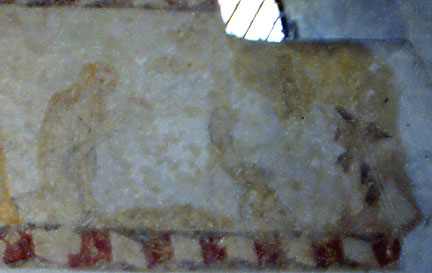
The geometrical borders, striving for the illusion of 3-dimensional space, are carefully organised, and these are the only areas of the Cycle to have been restored.
Similarities to a 14th century manuscript made at Peterborough¹ (not far away) have been noticed in these paintings and certainly the Cycle is of great interest Despite the dilapidation, it deserves better photographs, and these will be here as soon as I can arrange it.
There are other paintings in the church, including a Warning Against Idle Gossip and a Three Living and Three Dead now on the site.
¹ Bodleian Library MSt Barlow 22, Bodleian Library, Oxford